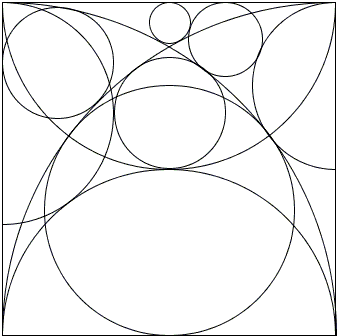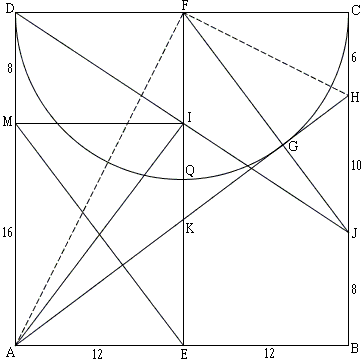Sangaku and The Egyptian Triangle

|
Three sangaku that require to determine the relative radii of the circles shown can be solved by a direct application of the Pythagorean theorem, see below, but if combined into a single (and a little amplified, sangaku-ready) configuration

|
reveal existence of possible relationships not obvious when they are studied separately. The configuration in fact, as was noted by L. Bankoff and C. W. Trigg quarter of a century before sangaku grew in popularity after a 1998 Scientific American article, is rich with surprises, the main being the numerous sightings of the famous 3:4:5 triangle.

|
The latter is most often referred to as the Rope-stretchers triangle and sometimes as the Egyptian triangle. (Both because of the belief that this simplest of the Pythagorean triangles was used by the ancient rope-stretchers in construction and, in particular, in construction of the Great Pyramids. Sometimes, however, the term Egyptian triangle is preserved for the one related to the dimensions of the pyramid of Cheops and the golden ratio.)

|
For convenience, assume the side of the square is 24 so that
HC = HG as tangents to (F) from H. For the same reason
Then HB = 18, AH = 30, AK = 15, KG = 9,
We see that triangles FCJ, HGJ, FGK, AKE, AEI, AEM, and ABH are all 3:4:5 triangles.

|
Let T be the intersection of AI extended with (A). Then
| RU = FI - SR = 8 - 16/3 = 8/3 = RT. |
In addition, if V is on BC and VC = RU, then
References
- L. Bankoff, C. W. Trigg, The Ubiquitous 3:4:5 Triangle, Math Magazine, v 47, n 2 (Mar., 1974), pp. 61-70
H. Fukagawa, D. Pedoe, Japanese Temple Geometry Problems, The Charles Babbage Research Center, Winnipeg, 1989
Write to:
Charles Babbage Research Center
P.O. Box 272, St. Norbert Postal Station
Winnipeg, MB
Canada R3V 1L6
Sangaku
- Sangaku: Reflections on the Phenomenon
- Critique of My View and a Response
- 1 + 27 = 12 + 16 Sangaku
- 3-4-5 Triangle by a Kid
- 7 = 2 + 5 Sangaku
- A 49th Degree Challenge
- A Geometric Mean Sangaku
- A Hard but Important Sangaku
- A Restored Sangaku Problem
- A Sangaku: Two Unrelated Circles
- A Sangaku by a Teen
- A Sangaku Follow-Up on an Archimedes' Lemma
- A Sangaku with an Egyptian Attachment
- A Sangaku with Many Circles and Some
- A Sushi Morsel
- An Old Japanese Theorem
- Archimedes Twins in the Edo Period
- Arithmetic Mean Sangaku
- Bottema Shatters Japan's Seclusion
- Chain of Circles on a Chord
- Circles and Semicircles in Rectangle
- Circles in a Circular Segment
- Circles Lined on the Legs of a Right Triangle
- Equal Incircles Theorem
- Equilateral Triangle, Straight Line and Tangent Circles
- Equilateral Triangles and Incircles in a Square
- Five Incircles in a Square
- Four Hinged Squares
- Four Incircles in Equilateral Triangle
- Gion Shrine Problem
- Harmonic Mean Sangaku
- Heron's Problem
- In the Wasan Spirit
- Incenters in Cyclic Quadrilateral
- Japanese Art and Mathematics
- Malfatti's Problem
- Maximal Properties of the Pythagorean Relation
- Neuberg Sangaku
- Out of Pentagon Sangaku
- Peacock Tail Sangaku
- Pentagon Proportions Sangaku
- Proportions in Square
- Pythagoras and Vecten Break Japan's Isolation
- Radius of a Circle by Paper Folding
- Review of Sacred Mathematics
- Sangaku à la V. Thebault
- Sangaku and The Egyptian Triangle
- Sangaku in a Square
- Sangaku Iterations, Is it Wasan?
- Sangaku with 8 Circles
- Sangaku with Angle between a Tangent and a Chord
- Sangaku with Quadratic Optimization
- Sangaku with Three Mixtilinear Circles
- Sangaku with Versines
- Sangakus with a Mixtilinear Circle
- Sequences of Touching Circles
- Square and Circle in a Gothic Cupola
- Steiner's Sangaku
- Tangent Circles and an Isosceles Triangle
- The Squinting Eyes Theorem
- Three Incircles In a Right Triangle
- Three Squares and Two Ellipses
- Three Tangent Circles Sangaku
- Triangles, Squares and Areas from Temple Geometry
- Two Arbelos, Two Chains
- Two Circles in an Angle
- Two Sangaku with Equal Incircles
- Another Sangaku in Square
- Sangaku via Peru
- FJG Capitan's Sangaku
|Contact| |Front page| |Contents| |Geometry| |Up|
Copyright © 1996-2018 Alexander Bogomolny
Let's, for example find the radius of (K) tangent to (A), (B) and AB. Actually we already saw that
| (24 - r)2 - r2 = 122, |
which gives
|
576 - 48r = 144, or 48r = 432, r = 9. |
|Contact| |Front page| |Contents| |Geometry| |Up|
Copyright © 1996-2018 Alexander Bogomolny
73596779
